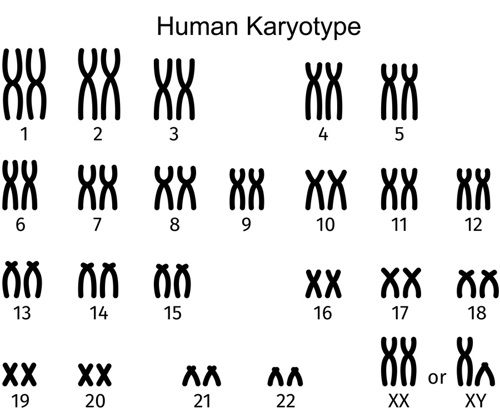
Who is more closely related genetically, siblings or a parent and child?
August 26, 2005

- Related Topics:
- Relatedness,
- Recombination
A curious adult from Pennsylvania asks:
“Hi, A question has been batted around the dinner table – who is more closely related genetically, siblings or a parent and child?”
On average, we are just as related to our parents as we are to our siblings--but there can be some slight differences!
We share 1/2 of our genetic material with our mother and 1/2 with our father. We also share 1/2 of our DNA, on average, with our brothers and sisters. Identical twins are an exception to this rule. They share all of their DNA.
The more distant the family relationship, the less genes we have in common. We share 1/4 of our DNA with each of our four grandparents, as well as our aunts and uncles.
Cousins have 1/8 of their DNA in common while second cousins are 1/16 alike. Our genetic likeness continues to drop by 1/2 with each increasingly distant branch in the family tree.
However, there’s an important distinction -- while everyone shares exactly 50% of their DNA with each parent, we share on average 50% of our DNA with our siblings. You can actually be slightly more or less than 50% related to a sibling, for reasons that are explained below.
To understand where these numbers come from, we need to understand how our DNA is organized in our cells.

DNA and Chromosomes
Our DNA is coiled into 23 pairs of chromosomes, giving us 46 chromosomes in total. Almost every cell in our body has a copy of all 46 chromosomes, with a few exceptions. Egg cells in women and sperm in men contain only a single copy of each of the 23 chromosomes. They have one half of each pair. But before the pairs get split apart in the eggs and sperm, a process called recombination occurs.
Recombination swaps DNA around between the matching chromosomes in each pair. Why is this necessary if the chromosomes match?
Well, they aren't exactly the same. There are small differences in the genes. DNA swapping scrambles around these small differences to create chromosomes in the eggs and sperm with unique combinations of genes. That way, we are all unique!
During reproduction, the 23 chromosomes in the mother's egg and the 23 chromosomes in the father's sperm combine. This results in a baby with an entire set of 46 chromosomes who shares exactly half its genes with its mother and half its genes with its father!

Relatedness with Siblings
We are also usually 50% genetically related to our sisters and brothers. But the reasons for this are different and have to do with statistics.
Like you, your siblings inherited 23 chromosomes from each of your parents. But because of DNA swapping, their chromosomes have a different combination of genes than yours. Yet on average, half of the genes are still the same.
Why is that? Remember, we have two copies of most of our genes. This means that your parents can pass either of their two copies down to you and your siblings.
Imagine your parent's genes as coins. The sides of a coin, heads and tails, represent the two copies of each of their genes. The chances of inheriting a head or a tail is just like flipping a coin, totally random.
Since we have 25,000 genes in our DNA, whether we inherit the head or tail of each gene is like flipping a coin 25,000 times. If we do that, we are most likely to get 1/2 heads and 1/2 tails.
So if you are inheriting 1/2 heads and 1/2 tails from your parents, the same is true for your sibling. In other words, the two of you are about 50% genetically related. You both may not have exactly 12,500 of each -- you may have 12600 heads and 12400 tails and your sibling has 12550 tails and 12450 heads -- but you are pretty close to 50%.

Author: Anne Tecklenburg Strehlow
When this answer was published in 2005, Anne was a Ph.D. candidate in the Department of Genetics, studying the genetics of Huntington’s disease in Rick Myers’ laboratory. Anne wrote this answer while participating in the Stanford at The Tech program.
 Skip Navigation
Skip Navigation
